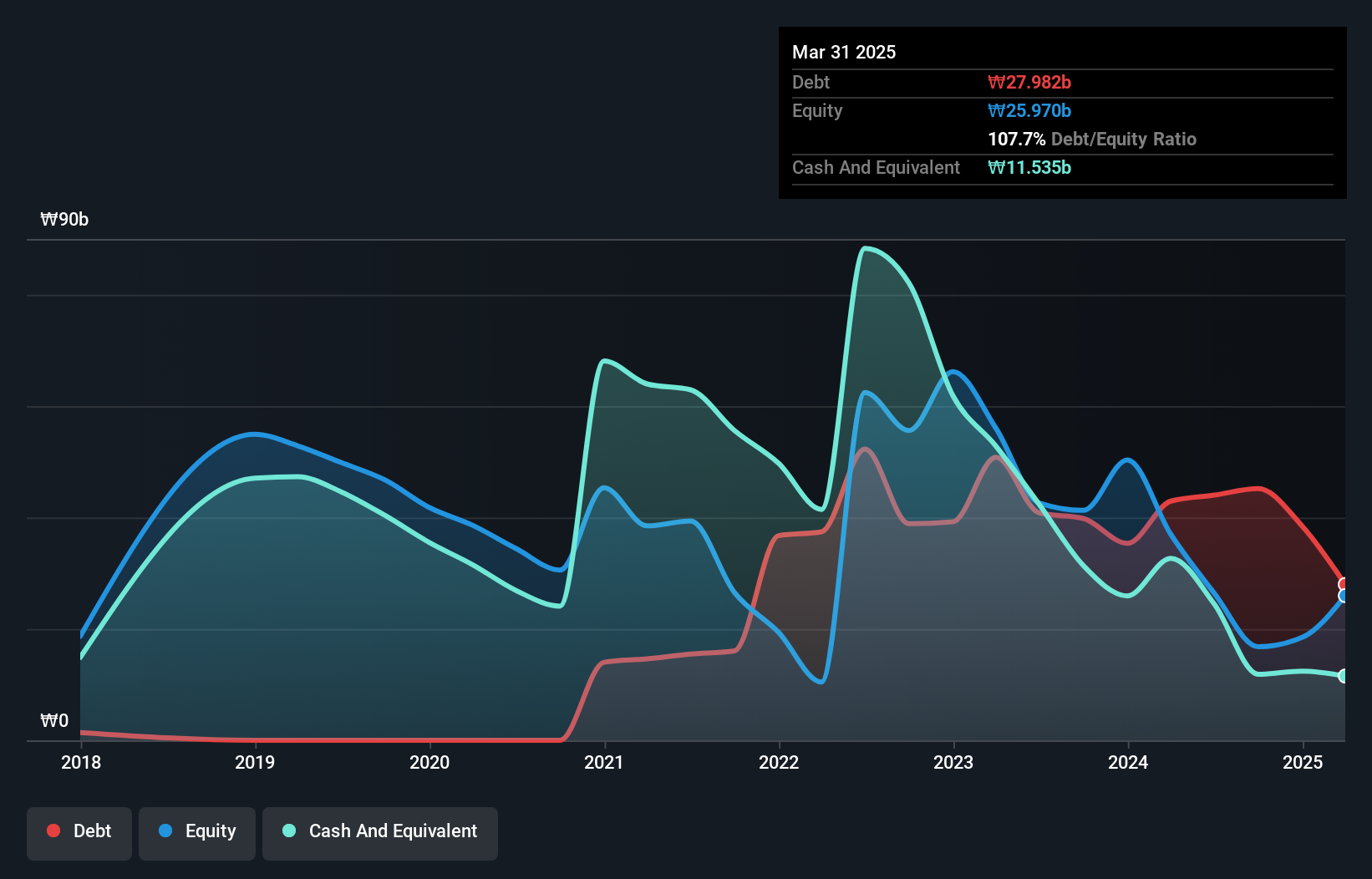Some say volatility, rather than debt, is the best way to think about risk as an investor, but Warren Buffett famously said that 'Volatility is far from synonymous with risk.' When we think about how risky a company is, we always like to look at its use of debt, since debt overload can lead to ruin. Importantly, OliX Pharmaceuticals, Inc (KOSDAQ:226950) does carry debt. But is this debt a concern to shareholders?
Why Does Debt Bring Risk?
Debt assists a business until the business has trouble paying it off, either with new capital or with free cash flow. Part and parcel of capitalism is the process of 'creative destruction' where failed businesses are mercilessly liquidated by their bankers. While that is not too common, we often do see indebted companies permanently diluting shareholders because lenders force them to raise capital at a distressed price. By replacing dilution, though, debt can be an extremely good tool for businesses that need capital to invest in growth at high rates of return. The first step when considering a company's debt levels is to consider its cash and debt together.
What Is OliX Pharmaceuticals's Debt?
The image below, which you can click on for greater detail, shows that OliX Pharmaceuticals had debt of ₩28.0b at the end of March 2025, a reduction from ₩42.9b over a year. However, it also had ₩11.5b in cash, and so its net debt is ₩16.4b.

A Look At OliX Pharmaceuticals' Liabilities
We can see from the most recent balance sheet that OliX Pharmaceuticals had liabilities of ₩20.9b falling due within a year, and liabilities of ₩22.0b due beyond that. Offsetting these obligations, it had cash of ₩11.5b as well as receivables valued at ₩919.9m due within 12 months. So it has liabilities totalling ₩30.5b more than its cash and near-term receivables, combined.
Of course, OliX Pharmaceuticals has a market capitalization of ₩769.2b, so these liabilities are probably manageable. But there are sufficient liabilities that we would certainly recommend shareholders continue to monitor the balance sheet, going forward. When analysing debt levels, the balance sheet is the obvious place to start. But you can't view debt in total isolation; since OliX Pharmaceuticals will need earnings to service that debt. So if you're keen to discover more about its earnings, it might be worth checking out this graph of its long term earnings trend.
Check out our latest analysis for OliX Pharmaceuticals
In the last year OliX Pharmaceuticals had a loss before interest and tax, and actually shrunk its revenue by 62%, to ₩5.9b. To be frank that doesn't bode well.
Caveat Emptor
Not only did OliX Pharmaceuticals's revenue slip over the last twelve months, but it also produced negative earnings before interest and tax (EBIT). Indeed, it lost ₩29b at the EBIT level. When we look at that and recall the liabilities on its balance sheet, relative to cash, it seems unwise to us for the company to have any debt. So we think its balance sheet is a little strained, though not beyond repair. However, it doesn't help that it burned through ₩35b of cash over the last year. So to be blunt we think it is risky. There's no doubt that we learn most about debt from the balance sheet. But ultimately, every company can contain risks that exist outside of the balance sheet. To that end, you should learn about the 5 warning signs we've spotted with OliX Pharmaceuticals (including 2 which are concerning) .
At the end of the day, it's often better to focus on companies that are free from net debt. You can access our special list of such companies (all with a track record of profit growth). It's free.
New: AI Stock Screener & Alerts
Our new AI Stock Screener scans the market every day to uncover opportunities.
• Dividend Powerhouses (3%+ Yield)
• Undervalued Small Caps with Insider Buying
• High growth Tech and AI Companies
Or build your own from over 50 metrics.
Have feedback on this article? Concerned about the content? Get in touch with us directly. Alternatively, email editorial-team (at) simplywallst.com.
This article by Simply Wall St is general in nature. We provide commentary based on historical data and analyst forecasts only using an unbiased methodology and our articles are not intended to be financial advice. It does not constitute a recommendation to buy or sell any stock, and does not take account of your objectives, or your financial situation. We aim to bring you long-term focused analysis driven by fundamental data. Note that our analysis may not factor in the latest price-sensitive company announcements or qualitative material. Simply Wall St has no position in any stocks mentioned.
About KOSDAQ:A226950
OliX Pharmaceuticals
A clinical stage pharmaceutical company, focuses on developing RNA interference (RNAi) therapeutics for dermal, ophthalmic, and pulmonary diseases.
Low risk with imperfect balance sheet.
Market Insights
Community Narratives




